|



























| |
|
THE
ADVENTURERS’ TRIP TO AUSTRALIA
by
Manuela Binotto & Valentina Sartor
|
|
Wow!
We were there, on the other side of the world. Our greatest dream
has become true, thanks to our teachers. They trusted us and they
accepted to start with us this amazing adventure.
When we left cold, snow-covered Montebelluna we were sorry, because
we had to leave behind our parents, boyfriends, relatives, friends
and two of our classmates, Anna & Martina; but we forgot
everything in the excitement for the long journey, which would take
us to discover a wonderful country, 20.000 km far from ours.
We reached Hong Kong
, the first coveted destination, after flying over uncharted lands,
sleeping, playing cards, studying maths (yes!) and eating
unwholesome food. We were relieved because we thought we were almost
there; but our relief vanished as soon as we realized that we were
only half way!  |
|
Fortunately
the time before our arrival literally “flew”, and before we knew
it we were landing in Melbourne .
Our host families were waiting for us in Moe
, Victoria .
They were anxious of meeting their adopted daughters, but we were
only dreaming of a comfortable bed where to rest our bodies and
minds.
Our partners made us feel at home from the very beginning. |
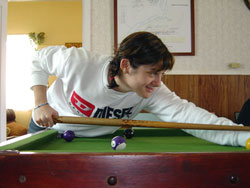
Studying applied physics...
|
|
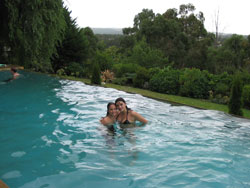
Fun
in the swimming pool? Nooo!
English lesson:
"this is a swimming pool"... ;-) |
The beautiful weather, the few days at school,
the frequent swims in the swimming-pool, the evening bbqs, spent
singing typical Italian and Australian songs accompanied by the
sweet sound of a guitar, everything made our stay unforgettable.
Our program was rich and eventful; even walking for hours and hours
was not tiring, and we made the most of our time, enjoying the
beauty of that marvellous country, and living every emotion
completely. |
|
Believe us when we say that we had a lot of fun, starting from the
two days spent at Yanakie Camping, where we overnighted after
exploring the beautiful landscape of Wilsons Promontory. There
we spent a wonderful time on the beach at night, together with our
new friends, in the warmth of our sleeping bags, admiring the
spectacular sky, full of unknown stars.
We had another chance to spend a night far from “our home”: on
1st and the 2nd March we stayed
in a hotel in the centre of Melbourne
.
|
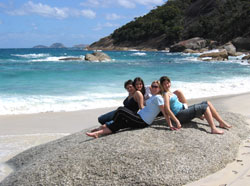
© Nicoletta
Galante 2004
Relax
on the beach? Nooo!
English lesson: "this is a beach"... ;-) |
|
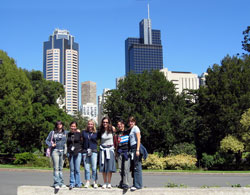
© Nicoletta
Galante 2004
Manuela,
Alessia, Irene, Giorgia,
Morena and Valentina in Melbourne
|
There we
visited a fair about the world of race cars and motors and some
buildings of modern art among which huge skyscrapers and small
churches stood.
We discovered the most famous sights of this city: the Queen
Victoria market and the spectacular Rialto Deck, situated at the
50th floor of a skyscraper, from which we could admire every
single detail of the Aussie city..
We couldn’t miss a visit to Healsville Sanctuary too, where we had
a chance to meet koalas, kangaroos, echidnas, dingoes and other
typical Australian animals.

|
|
There
penguins were not there, though: we had to go to Phillip
Island and to travel for hours to visit them, but it was worthwhile!
We saw their “Parade”: they were returning from their long day
spent at sea searching for food.
Three of us, the luckiest ones, Valentina, Morena and Irene, went to
the fantastic city of Sidney for a few days’ stay.
They had a lot of fun. They said that the city is beautiful and the
aquarium that hosts countless fish from all over the world is
enormous!! |
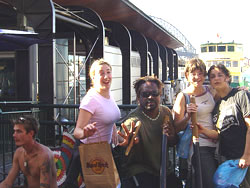
Australian
rock is inspired by Aboriginal instruments, like the didgeridoo |
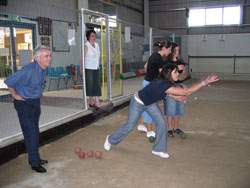
© Nicoletta
Galante 2004
A
game of "bocce" at the Italian-Australian Club
of Morwell: it is Manuela's turn...
|
The last
but one day we visited “Mid Valley” in Morwell, where we could
enjoy our favourite hobby: shopping.
Then we had lunch at the “Italian-Australian Club”, where we
could play “bocce”, discovering new talents (Prof. & Prof)
;)
After two weeks of fun, our Australian dream was over, with tears,
sighs, songs, goodbies and promises to come back.
But in our hearts we still have the smiles of those special and
extraordinary people who made this experience UNFORGETTABLE!!!!
|
Special
thanks to: 4 F, our teachers, Australian teachers, partners and
families and of course OUR families, who helped us to fulfil a dream
which will last FOREVER...
SEE YA , AUSTRALIA!!!!!!
|
|
VICTORIA
AND WATER
by Giorgia Tommasi
|
|
During
my stay in Victoria, I discovered that water is considered one
of the most precious things in Australia. While we take water for
granted and waste it without considering its importance, Australia,
which is the driest continent and has been experiencing a long
period of drought,
must find ways to conserve and reuse this precious resource. Even if Victoria is one of the
greenest states of Australia, it is still subject to dry seasons and
periods of drought, which cause stress and problems to families,
farming and the economy.
In fact, over 75% of Victoria’s
water supplies are used for irrigation: irrigated agriculture
is at the the basis of Victoria’s
economy, and it produces an output worth $2 billion a year. However,
it requires a lot of water, and rain is becoming less and less
frequent, due to deforestation and other human activities. |
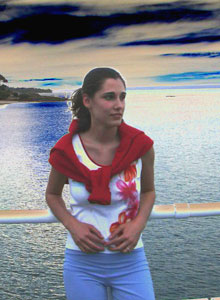 |
|
This is why only 23% of Victoria’s
rivers can be considered in good conditions, whereas a third of them are in poor or even very poor
conditions.
Also, two
thirds of Victoria’s
wetlands have been lost or degraded. The poor health of rivers and
wetlands has led to the loss
of the fish, birds, animals and plants that depend on water.
In
fact, 420
species, that is 20% of plant species and 35% of animal
species, as well as 40% of native fish are considered threatened. |
|
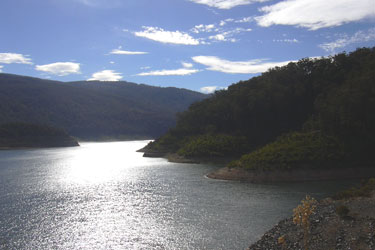
Thomson
Water Supply Reservoir provides
safe, high quality drinking water
for the city of Melbourne |
The lack of water has also caused an increase in
water treatment costs, as well as an algal bloom in the ocean
which damages tourism.
The
NRE (Department of Natural Resources and Enviroment) coordinates the
State Government’s response to the drought.
In July 1999 the
Commonwealth and the States decided a National Drought Policy, which
aims to reducing potable water use in the house and industry
through:
|
|
 permanent water saving measures
permanent water saving measures
 education and awareness;
education and awareness;
 ensuring that new developments reduce water use;
ensuring that new developments reduce water use;
 rules that support water conservation and facilitate recycling;
rules that support water conservation and facilitate recycling;
 reducing illegal use of water;
reducing illegal use of water;
 increasing the use of recycled water for industry and
enviromental uses.
increasing the use of recycled water for industry and
enviromental uses.
|
There
are four different kinds of water:
RAINWATER:
it is captured through rainwater tanks, used for household needs;
GREY
WATER: it comes from bathrooms (not toilet) and kitchens, it can be
used for gardens and toilet flushing;
STORM
WATER: it runs off from roads, footpaths, parks and gardens; it is
used for irrigation of sportive grounds and public open spaces;
RECYCLED
WATER: it can be used for gardens, toilet flushing and some
industrial processes.
Collecting
rainwater is getting more and more important. Most houses have
rainwater tanks, which have been used in rural Australia
for 200 years. However, it is not so in cities.
It
is estimated that if just 1% of homes in metropolitan Melbourne
installed a 2250-litre water
tank, more than 70 million litres of
water could be saved every year.
A
family of four uses up to 250,000 litres of water a year, of which:
35%
garden
19%
toilet
20%
bathroom
15%
laundry
5%
kitchen
Rainwater
can be used for the garden and for toilet flushing (over 50% of
all the water used by families) and then the Melbourne
water supply could be used for drinking.
Anyway,
there are a lot of ways through which everyone can save water:
 |
cutting
the shower time from 4
to 7 minutes could save 25000 litres per person every year; |
 |
turning
off the tap when shaving can save 3500 litres a year; |
 |
installing
a dual-flush toilet can save 35000 litres every year for a family of
four; |
 |
using
the dishwasher only when it is full and using the economy setting; |
 |
watering
the garden in early morning to reduce evaporation; |
 |
checking
the outdoor taps and pipes regularly (one dripping tap can waste
5000 litres a month)! |
And
even if in Europe we don't have the same serious water problems as
Australia, we should still think about it and try not to waste the
most precious of all resources.
|
|
|